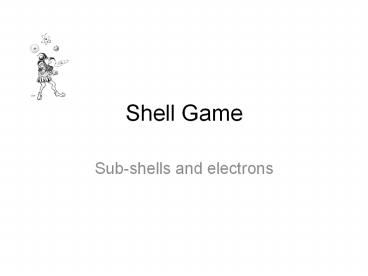Shell Game - PowerPoint PPT Presentation
1 / 25
Title:
Shell Game
Description:
Name at least two similarities. 1s 2s 2p 3s 3p 3d 4s 4p 1 2 3 4 Discussion results Similarities Differences Unit 1 Investigation III The Big Question How do ... – PowerPoint PPT presentation
Number of Views:841
Avg rating:3.0/5.0
Title: Shell Game
1
Shell Game
- Sub-shells and electrons
2
ChemCatalyst
- The two drawings show two ways of representing
the electron arrangement of the element calcium,
Ca. - Name at least two differences.
- Name at least two similarities.
Unit 1 Investigation III
3
Discussion results
- Similarities
- Differences
4
The Big Question
- How do electron subshells relate to the periodic
table?
Unit 1 Investigation III
5
You will be able to
- Identify an element based on its electron
configuration.
Unit 1 Investigation III
6
Notes
- Electron shells are divided into electron
subshells. - Subshells are determined by amount of electrons
and energy level of those electrons
Unit 1 Investigation III
7
Reason for the configuration
- Electrons groups are placed in different rows
based on the amount of energy they possess - Electrons can only possess certain amounts of
energy and achieve even a temporary amount of
stability - Amount of energy correlates to position. The
positions nearest the nucleus require the least
energy
8
Activity
- Purpose This lesson introduces you to electron
subshells. You will explore how they are related
to the periodic table.
(cont.)
Unit 1 Investigation III
9
S-P-D-F
- S(ome) P(eople) D(ont) F(orget)
- S subshells hold the fewest electrons at the
lowest energy levels - F subshells hold the most electrons with the
highest energy levels
10
The difference between orbitals and subshells
Sublevel of orbitals it contains (1st 4 odd s) Total of electrons it can hold (2 x the of orbitals)
S 1 2
p 3 6
d 5 10
f 7 14
11
Notes
- An electron configuration is a list of all the
subshells that have electrons for a given
element. - The number of electrons in a subshell is
specified as a superscripted number.
Unit 1 Investigation III
12
Writing the electron configuration for an element
- The subshells are filled according to the amount
of energy required for each electron - 1s requires the lowest, 2s follows
- Partial list, 1s, 2s, 2p, 3s, 3p, 4s, 3d, 4p, 5s,
4d, 5p
13
(No Transcript)
14
Configuration for different elements
- Hydrogen 1s1
- Oxygen 1s2 2s2 2p4
- Aluminum 1s2 2s2 2p6 3s2 3p1
- Argon
- Calcium
- Chromium
- Selenium
15
Arrow diagram for order of filling sublevels
- Color your copy
- 4 blocks where you will be adding electrons to
different sub-shells, one block for each
sub-shell letter (s, p, d, f)
16
(cont.)
Unit 1 Investigation III
17
(cont.)
Unit 1 Investigation III
18
Another way to determine the order that subshells
are filled
19
Shorthand configuration for larger elements
- The configuration can shortened by writing the
symbol of the nearest noble gas with a smaller
atomic number - Example
- The configuration for Magnesium is
- 1s2 2s2 2p6 3s2
- Or it can be written as Ne 3s2
20
In class questions
21
(cont.)
Electron configuration Element
1s22s1
1s22s22p3 nitrogen, N
1s22s22p63s23p5
1s22s22p63s23p64s23d6
1s22s22p63s23p64s23d104p2
1s22s22p63s23p64s23d104p65s24d105p4 tellurium,Te
Unit 1 Investigation III
22
Making Sense
- How is the organization and structure of the
periodic table related to electron subshells?
(cont.)
Unit 1 Investigation III
23
Check-In
- Identify the element with the following electron
configuration. - 1s22s22p63s23p64s23d104p3
Unit 1 Investigation III
24
Wrap-Up
- Electron shells can be divided further into
subshells, referred to as s, p, d, f. - Each subshell can hold a specific maximum number
of electrons. The s subshell can hold 2
electrons, the p subshell can hold 6, the d
subshell can hold 10 electrons, and the f
subshell can hold 14.
(cont.)
Unit 1 Investigation III
25
(cont.)
- The periodic table can assist us in figuring out
the sequence of filling the subshells with
electrons. - Chemists keep track of electrons and the
subshells they are in by writing electron
configurations.
Unit 1 Investigation III































